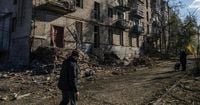Ukraine’s war with Russia has entered a new and volatile phase, marked by a dramatic escalation in attacks on each other’s energy infrastructure. As both sides trade strikes deep behind enemy lines, civilians across the region are left grappling with power outages, fires, and the ever-present anxiety of the next barrage. The latest developments, reported by outlets including POLITICO, BBC, ZN.ua, and Ukrenergo, reveal a conflict increasingly fought not just on the front lines, but across the power grids and oil depots that sustain modern life.
For much of the war, Russia’s relentless strikes on Ukrainian cities and electrical facilities went largely unanswered. But as 2025 unfolds, Kyiv has shifted to a more sustained and systematic campaign of deep strikes against Russian territory, with a particular focus on energy infrastructure. According to POLITICO, Ukraine has now hit 21 out of Russia’s 38 major refineries this year, degrading around 38% of the country’s refining capacity. The BBC confirms these attacks have contributed to fuel shortages within Russia, forcing Moscow to import petrol from Belarus—a rare reversal of fortunes in the energy-rich nation.
Ukrainian President Volodymyr Zelenskyy has made the logic behind this new campaign clear: “The enemy must bear the cost of this war. But we do not kill civilians,” he said, emphasizing a strategy designed to impose pain on the Kremlin while avoiding civilian casualties. The intention, according to Kyiv, is to make the war so costly for Russia that the Kremlin is compelled to rethink its approach. “More pressure on Russia is needed. Pressure will work—when they lose more from war than they would in any other scenario. Our long-range strikes, strong sanctions, holding the battlefield, defending ourselves—but also, undoubtedly, supporting peaceful initiatives, because that’s the right thing to do—this will work,” Zelenskyy told POLITICO.
This escalation is not one-sided. On October 10, 2025, Russia responded with overwhelming force, launching over 450 drones and about 30 missiles at Kyiv and other Ukrainian cities, resulting in partial blackouts. In just one recent week, Russian forces unleashed more than 3,100 drones, 92 missiles, and roughly 1,360 glide bombs, with a significant portion aimed at Ukraine’s own energy infrastructure.
Ukraine’s growing arsenal has been central to its expanded campaign. Zelenskyy and other officials have highlighted the country’s increased domestic production of long-range and more lethal drones and missiles, reducing reliance on foreign deliveries. Among the new weapons in use are the Palianytsia and Ruta drone-missiles, which have reportedly struck Russian ammunition depots and even maritime platforms in the Black Sea, up to 250 kilometers from Ukrainian territory. The Flamingo cruise missile—first reported by POLITICO in August—boasts a range of 3,000 kilometers, while the shorter-range Neptune missile has also begun striking targets inside Russia. “I won’t give numbers—we have used our Neptune and Flamingo missiles in pairs. We are not talking about en masse use of this pair. We are only saying that it has been used, and there are initial signs of such success with this particular weapon,” Zelenskyy said.
Western support remains a crucial, if sometimes understated, element of Ukraine’s strategy. U.S. intelligence cooperation has been described by Ukrainian officials as “very active,” with the Financial Times reporting that the U.S. has provided targeting information to help Ukraine strike Russian energy facilities. This intelligence, Kyiv says, has been especially helpful in understanding Russian intentions and bolstering air defense efforts.
The effects of these attacks are being felt far from the battlefield. In occupied Crimea, drone attacks on the night of October 16-17, 2025, struck energy and oil infrastructure, causing fires and widespread power outages. According to ZN.ua, several substations in Crimea were damaged, and the region’s governor, Serhiy Aksyonov, confirmed emergency power outages near the Krasnoperekopsk district. The so-called head of the Council of Ministers of Crimea, Yuriy Hotsanyuk, also reported interruptions in electricity supply due to UAV attacks on substations. In Yevpatoria, school classes were canceled, with the city left without both electricity and water supply.
The Telegram channel “Crimean Wind” reported explosions across the peninsula between 3 and 5 a.m., with at least one main substation damaged and an oil depot in Hvardiiske near Simferopol burning since the night. The depot, belonging to the ATAN gas station network—the largest on the peninsula—was not the only target. Ukrainian Defense Forces also struck a fuel and lubricants depot for Russian troops in Dzhankoi and the Nebo-U radar station in Yevpatoria. Notably, a Russian Su-30SM aircraft was destroyed, likely due to friendly fire as air defenses attempted to repel the drone attack. Explosions were also reported overnight in Saky and Novofedorivka, sites of Russian military airfields. Just days earlier, on October 13, a Ukrainian attack damaged 16 fuel tanks at a maritime oil terminal in Feodosia, underscoring the sustained nature of Kyiv’s campaign.
The fallout from these strikes is not limited to Russian-controlled territory. Inside Ukraine, the consequences of Russia’s own attacks on energy infrastructure are being acutely felt. On October 17, 2025, electricity consumption soared due to cloudy and cold weather, and emergency power outages were introduced in Kyiv and 12 other regions, including Cherkasy, Zhytomyr, Kharkiv, Sumy, Poltava, Zaporizhzhia, Kirovohrad, Dnipropetrovsk, and parts of Chernihiv, Khmelnytsky, and Vinnytsia. Ukrenergo, the national energy company, reported that these outages were the direct result of previous Russian strikes and ongoing emergency repair works. In Chernihiv region, hourly outages across three stages were implemented due to systematic enemy attacks over the past several weeks.
Power-limitation schedules for industrial consumers were in place from 7 a.m. to 10 p.m. across all regions. The situation remains unstable, with energy workers scrambling to monitor the power balance and restore supply amid the ongoing barrage. Ukrenergo has warned that emergency outages may continue for another week, and citizens are being urged to conserve electricity by limiting the use of power-hungry appliances.
The war’s new front—fought with drones, missiles, and sabotage—has turned energy infrastructure into both a weapon and a target. As Ukraine and Russia escalate their campaigns, the civilian populations on both sides bear the brunt of blackouts, fuel shortages, and the uncertainty of what tomorrow might bring. For now, the power struggle shows no sign of abating, with each side determined to make the other feel the true cost of war.





